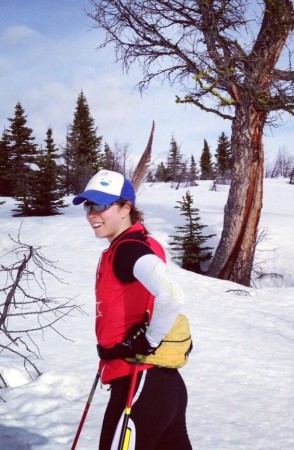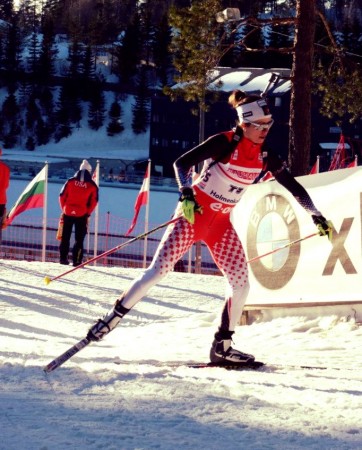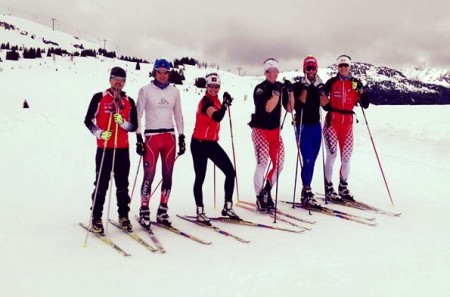
The 2011/2012 season was a good one for Megan Imrie. The Canadian biathlete had the four best results of her career, including her first two top 20’s. Along with Zina Kocher, Brendan Green, and Jean Philippe Le Guellec, she was part of a mixed relay that finished a landmark sixth on the World Cup in Hochfilzen, Austria. Along with the rest of Canadian biathlon, things seemed to be on an upward swing for the 2010 Olympian.
But the next season brought challenges for almost that whole relay team. Kocher had a subpar season; Green was out with back problems; and by the end of the first period of World Cup racing, Imrie knew that something was wrong. She was struggling, only breaking into the top 60 once and more often falling into the 70s or, worse, the 90s.
“I was asking my body to perform and there was absolutely nothing there,” Imrie told FasterSkier in an interview this week.
So, knowing that things were only going to get worse if she kept pushing, she did the only thing that was left: she went back her parents’ ranch in Falcon Lake, Manitoba, settled in with her family for the -40 degree winter, and didn’t think about biathlon for a few weeks.
Imrie now knows that her season was sabotaged by a combination of overtraining and the illnesses and injuries that plagued her almost every month in off-season. But at the time, neither she nor her coaches could quite add up the pieces of the puzzle.
“It was an extremely frustrating time, because no one knew really what was going on,” Imrie explained. “I felt I’d done the training I was capable of, but I was falling miles short of where I knew I could be in races. People were asking me why this was happening and I had no answer.”
During her mid-winter break, Imrie did a lot of thinking. By the time she returned to action for the last World Cups of the season, she had a question she needed to answer.
“The first was to see if this if biathlon is what I really wanted,” she said.
The answer? Yes. And so she’s setting about training this summer and fall with a vengeance – a smart, measured vengeance, from the shooting range in Canmore, where the national team is based, to the late-spring snow higher up in the mountains where skiers can still do long workouts in June.
“So far it’s looking like I’m in a better place, physically and mentally, than I’ve ever been,” Imrie reported. “I’m truly motivated to be as strong as I can for the winter. Part of this comes from being healthy. Knowing just how bad I felt last year makes me appreciate what I’m capable of now. It’s a pretty nice view from the glass-half-full perspective.”
Back on the Ranch
“Once I got home from Europe at Christmas, I was ready to use my skis as kindling and throw my rifle in a snowbank,” Imrie said. “Deciding to give myself as much time as it might take to recover was a decision I probably should have made earlier.”
The circumstances for her return to Manitoba were definitely less than ideal. Yet they also presented a unique opportunity. Only about once a year, in April, do skiers and biathletes have the chance to completely leave their sport for a few weeks, set their minds to other things, and rejuvenate. During years on the European circuit, they barely ever get to see their families during the winter, or do any of the fun wintertime activities at home that they remember from growing up.
So Imrie took her mid-season break and embraced it.
“I was able to forget about biathlon and get some true, deep rest the best way I know how,” she said. “Home on my parent’s ranch, it was probably the coldest I’ve ever seen the thermometer. In the -40’s. But that didn’t stop us from spending a day on the trapline, snowmobiling through rugged backcountry. We had bonfire lunches in waist deep snow, harnessed the horses for sleigh rides, and just spent time together. On a days like those, I couldn’t have been further from the crowds of World Championships, and it was just what I needed.”
There were times, too, when she was brought back to biathlon, and reminded of why she had been so involved in this sport in the first place.

“There were a number of great moments when I was back that helped me out,” Imrie said. “One was visiting an elementary school in my boyfriend’s hometown in northern Manitoba. There’s really nothing like being told ‘I want to be a biathlete just like you’ to make you smile.”
She spent her 27th birthday in Canada, looking on from afar as her team competed at World Championships. That day, Le Guellec placed tenth in the 20 k individual race; southern neighbor Tim Burke won a silver medal for the U.S.
This season, North Americans have proved more than ever that they can cut it on the world stage. But for Imrie, the greatest thing that will allow her to contribute to that onslaught might have been staying at home with her horses.
“To spend time around horses takes me back to how I grew up and who I am,” Imrie said. “Their laid-back attitudes, childlike curiosity, and ‘right now’ thought processes are great reminders to an on-the-move athlete.”
Race Ready Again
After a few weeks, Imrie returned to Canmore, where she met with her doctor and the team’s sports physiologists. After some tests, she was declared healthy to train again. It was a relief.
“I could feel strength and improvements- something I’d been void of since sometime in 2012,” she admitted. “I was able to put in about two or three solid weeks before I went to Oslo and Sochi.”
That’s not enough of a base to be competitive, so Imrie tried to push results out of her mind when she returned to the unforgiving World Cup. But besides deciding whether biathlon was really what she wanted to devote her life to, she had an important mission: to scope out the Sochi courses for the upcoming Olympics.
“[I wanted] to drink in and learn the Sochi course,” she said. “And I think the race course at Sochi was excellent. Of course, it was hard. The cumulative feel of the climbs was unlike anywhere I’ve raced, and the downhills took technique and guts to do well and safely. But that said, I really enjoyed it.”
If anything, that has made Imrie more motivated to train this summer and be full-strength for her second Olympics. She’s part of what she reports is Biathlon Canada’s biggest national training group “in a while,” although it’s mostly made up of men; of this year’s four-woman World Championship team, Kocher trains with the Biathlon Alberta Training Centre, Megan Heinicke lives in Germany, and Audrey Vaillancourt stays home in Quebec. So it’s Imrie, Rosanna Crawford, and the guys.
But that’s no problem.

“It’s a fun group, everyone’s been really eager to make solid training happen,” Imrie said. “The nice thing about biathlon is that training is often centered around the range, so in a workout, you’re never on your own for very long.”
She and Crawford have plenty of other training buddies too, outside their team.
“Canmore is also a very nordic community,” she explained. “There are always friends in town to train with. I often meet up with Perianne Jones, Zina Kocher, the World Cup Academy ladies, or other non-racing friends for workouts. In July, Rosanna, Audrey and I will join the Americans in Lake Placid for a camp. It will be great to catch up with them and pump out some hard intensity with more sparring partners.”
A high point of the early training season has been the chance to get on snow. In the fall, Canmore offers early skiing by way of Frozen Thunder, a snow-saving operation. But in the spring, if offers the same thing as athletes ramp up again via a more joyful backcountry route. In May, the team would hit up nearby Mount Shark. Since that melted they’ve been heading to Sunshine, a 45 minute drive, about once a week.
“It’s a special place this time of year,” Imrie said. “Usually there’s perfect crust skiing conditions, but if not, there is an excellent groomed loop on rolling terrain. It’s very high there (I think about 2500 meters) so we’ve been doing morning long distance workouts.”
It’s great from a nuts-and-bolts perspective: as the athletes hit the rollerskis again and build strength in the gym, they have the chance to directly apply those changes to their on-snow technique and get the most out of any improvements.
But it’s also a reminder of the joy and adventure in their sport, something that Imrie now appreciates even more fully.
“We can drive right up the mountain to the village, from there we hike or ski about 10 minutes up to the meadow which is where the best skiing is,” she said. “It’s really fun natural terrain and tree skiing. When the crust is good, you can ski for a couple hours before the sun softens the crust too much. When your poles start to punch through, you know it’s time to head back to the groomed trail. The workouts go by quickly when there’s so much exploring to do.”
Chelsea Little
Chelsea Little is FasterSkier's Editor-At-Large. A former racer at Ford Sayre, Dartmouth College and the Craftsbury Green Racing Project, she is a PhD candidate in aquatic ecology in the @Altermatt_lab at Eawag, the Swiss Federal Institute of Aquatic Science and Technology in Zurich, Switzerland. You can follow her on twitter @ChelskiLittle.



